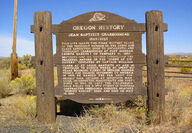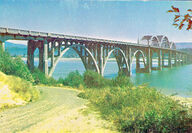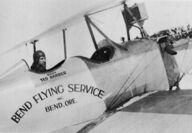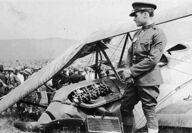Sorted by date Results 1 - 25 of 42

Happy New Year! At the time of this writing, it’s just a few days before Anno Domini 2025 is scheduled to inflict itself upon us. This time of year, many writers make a regular practice of looking back upon the past year and writing about it. I suspect this practice got started with Penny Press-era newshounds who found it very hard to track down sources during the week after Christmas — or maybe they just wanted to relax and bang out an easy story so they could get back to wassailing or spe...

Far away from the Beaver State, in the backcountry of West Virginia by the Kentucky border, a man named Floyd Hatfield was the proud owner of a fine razorback hog. A distant neighbor, from across the Tug River on the Kentucky side, saw the hog one day, and claimed the hog was really his. He could tell, he said, by the distinctive notches in the hog’s ear. Hatfield was enraged; the neighbor was basically calling him a thief, an insult that was, in the heart of Appalachia just after the Civil W...

In the past few decades, professional soccer has made great strides in the U.S., and hockey has always had an enthusiastic cult following. But the Big Three are still the same as they were in 1970: Baseball, football, and basketball. Before 1970, Oregon was home to exactly zero major-league teams from any of these sports. But after 1970, it was home to one: The Portland Trail Blazers, a basketball team that took just over five years to build a team that would win the NBA World Championship and...

One of the real privileges of being a lifelong Oregonian of a certain, er, vintage, is the opportunity to have seen this state in its golden age — roughly, 1946 through 1980 — through a child’s eyes. The basic style and culture of the Beaver State have changed a lot over the last 50 years. And, for the most part, it’s changed for the better ... but not entirely. Sociologists would say this change was the transition from a “modernist” culture — proud, conformist, and optimistic about the fut...

It’s widely known that the first newspaper west of the Mississippi River was the short-lived Oregon Spectator, which published its first issue on Feb. 5, 1846. But that’s only true if you define “newspaper” very narrowly. In truth, there was an earlier publication that met every definition of a newspaper but one ... specifically, it was “printed” by hand, every copy, with pen and ink — longhand. No printing press was involved. This early newspaper was called The Flumgudgeon Gazette and B...


When cherry season rolls around, there’s never much doubt about what varieties you’ll find in your local grocery store. They’ll usually have some white or blush cherries, typically Royal Anne or Rainier; but most of them will be Bings. Among cherry fans, the deep-red Bing is the gold standard, and has been for well over 100 years now. Rich and sweet, almost like chocolate in its intensity of flavor, the Bing dominates the supermarket and is most people’s favorite variety. And there is probabl...

There were times, during Hollywood’s golden age, when Clark Gable simply couldn’t be found anywhere. Studio executives would search frantically for the top-shelf star, needing to talk to him about a project and facing a tight deadline. He’d be gone. In fact, he’d be fly-fishing on the Rogue River in Oregon, while staying in a small inn that today is the oldest continually operating hotel in the entire Pacific Northwest: The Wolf Creek Tavern. Clark wasn’t the only Hollywood bigshot in on the se...

Sometime in 1922, a letter came in to the city of Pendleton. Enclosed with it was a bill for $45 — for a set of new Goodyear tires. It seemed the letter writer had come to Pendleton for the annual Pendleton Round-Up and had lost both front tires to the city’s downtown potholes. The writer also suggested that the city post warning signs at city limits reading, “If you want to experience the joys of a bucking horse, and you own no horse, just drive the streets of Pendleton.” And indeed, Pendlet...

As of the time of this writing, it’s election season, and some of us are being asked to approve bond measures for local schools. So, most likely I don’t have to tell you that such debates can get pretty heated. We should count our blessings, though. Some Oregonians used to argue over this sort of thing with dynamite. More specifically, a few of the residents of the unincorporated hamlet of Mohawk did. Mohawk is situated in the heart of the Mohawk River Valley a dozen or so miles northeast of...

One of the more interesting things about Oregon history is how much of a role “colorful characters” played in it. Until a few dozen years ago, historians didn’t much like talking about the contributions of prostitutes, swindlers, shanghaiers, and other underworld characters to Oregon’s history, preferring to talk about brave pioneers and clean-living homesteaders and noble missionaries and such. So it’s no surprise that the name and identity of the first woman of European extraction to set fo...

The climactic scene is the main thing people talk about in South Lane County when this movie comes up. It was literally a train wreck, although metaphorically, it was anything but. Buster wanted the movie's climax to involve a locomotive falling through a burning bridge into a river. With this in mind, although he borrowed the two main lakes from local logging shows, he purchased the third outright. He had plans for that third locomotive that probably would not be approved by its owner unless...

If a Cottage Grove logger had been bonked on the head in January 1926 and woke up six months later, he would have scarcely recognized his hometown. There was a whole new Main Street built way out east of Main Street, with businesses and boardinghouses and banks and everything. Meanwhile, back on the old Main Street, everyone in town was clustered around the Bartell Hotel, dressed in weird, archaic outfits like it was Civil War times. And there were a pair of old steam logging locomotives,...

When mayors of incorporated cities start talking about growth, it’s hard to beat the story of Steve Smith, who until a few years ago was mayor of the historic mining town of Granite, Oregon. When I spoke to him in 2009, Steve told me Granite’s population had shot up 2,800 percent over the previous 40 years, since 1970. So, what was the secret of Granite’s amazing growth rate? Simple: Start with a really small number. And it didn’t get much smaller than Granite’s population in 1970. At that time,...

The thing was, by late 1883, the Vigilantes’ popularity had collapsed, and they didn’t know it. Basically, by this time, everyone who wasn’t one of them was an opponent — but, of course, nobody dared say so. But several of the other folks in the saloon that night were happy to trot on over to Blakely’s place and tell him what Winckler had said about him, and Blakely was furious. He and several friends charged down to the saloon, but by the time they got there the Vigilantes had gone home. The...

In the months that followed the murders of A.H. Crooks and Stephen Jory, as detailed last week in Part One of this two-part series, the members of the mob that lynched their killer formed themselves into a secret shadow government. They became known as simply “the Vigilantes,” and although they undertook their operations wearing masks and under cover of darkness, everybody pretty much knew who they were. And that was a problem because who they were was the cream of Prineville’s social elite...

It was the Ides of March — March 15, 1882. A man named A.H. Crooks had filed a homestead claim on a piece of land near Prineville. He and his hired hand, Stephen Jory, were out on the land now, cutting blaze marks on trees along the property line. Except, it wasn’t the property line. The clerk in the county seat, way up in The Dalles, had made a mistake and tried to give Crooks a big slice of the homestead next door, which was owned by a cantankerous fellow named Lucius Langdon. Crooks and Jory...

The problem with opium was, that although the stuff was still legal, it was taxed very heavily. That meant smuggling the stuff in without paying the tax was tantamount to stealing money from the government. When Dunbar smuggled a Chinese guy into the country to work, that was illegal, but nobody cared; it was a big country, and there was lots of work to be done. But when Dunbar smuggled a barrel of opium into the country, the government lost thousands of dollars in tax revenue. Most likely,...

One of the most significant events in the history of the world took place in 1892, when a corrupt political hack named James Lotan managed to land a cushy government job as the head of the customs inspection service for the Port of Portland. Believe it or not, Lotan’s landing that job led directly to Pearl Harbor and eventually Hiroshima and Nagasaki, and indirectly to the defeat of Nazi Germany in Europe. Not bad for a small-time white-collar criminal in a tiny backwater seaport town on the f...

It should be stressed that this was before Europe and European America had learned contempt for Indians. Before about 1825, tomahawks were thrown and scalps were taken on both sides (especially during the War of 1812), but being half-Indian was nothing that any métis youth would be ashamed of. That would happen later, and Charbonneau would be there watching it happen. In the meantime, it was still the early 1820s and Charbonneau was most likely the talk of the town everywhere he and Duke Paul...

It’s really easy, looking back at history, to think stuff was “meant to be.” When we look back at how the American West was incorporated into the nation, we see it was shaped in the spirit of Manifest Destiny. We see settlers from the east moving out and seizing big chunks of Indian lands, claiming it was God’s will and pointing to the pandemics that were decimating the tribes as a sort of Old Testament-style confirmation of their status as God’s chosen new landowners. The course of Western h...

Anyone who’s done much driving around Oregon — especially along the coast — knows the state’s bridges have a particular and distinctive style. That style is hard to put your finger on, isn’t it? The bridges themselves are very different from one another. Many of them aren’t even built with the same materials. The spectacular structure that soars over Coos Bay could not be much different in size, technique, and style from the elegant little archway that links Oregon City with West Linn; but e...

Continued From Last Week The Waco’s engine droned on. Ted couldn’t understand why it was still running. It should have sipped its last drop of gasoline several minutes ago. Sooner or later it would run out, and Ted would have to do his best at a dead-stick landing in the black, gusty night, unable to see the ground below. The most likely outcome would involve him thinking he was just above the ground when he wasn’t — it’s very hard to deliberately fly into the ground, and the instinct to pull ba...

On a gusty late-summer evening in 1930, well after dark, a few feet off the ground near the Oregon-Nevada border, 22-year-old Ted Barber was hurtling through the blackness, preparing to die. Barber was an aviation pioneer and an actual barnstormer — a pilot who paid the bills by making the circuit of county fairs and country dances, selling airplane rides and flying lessons, and performing daring tricks like wing-walking and inverted low passes. His ”ship” was a Waco 9, a primitive but rugge...

Continued From Last WeekI In the course of doing this, Cressman gleaned an understanding of the cultures of “ancient Oregonians” — an understanding that formed into a theory that put him at odds with the conventional wisdom of nearly every other scientist at the time. Essentially, every archaeologist but Cressman was convinced that the Clovis People, an ancient culture named after a New Mexico town where their artifacts had been first discovered, had been the first humans to ever live in North...